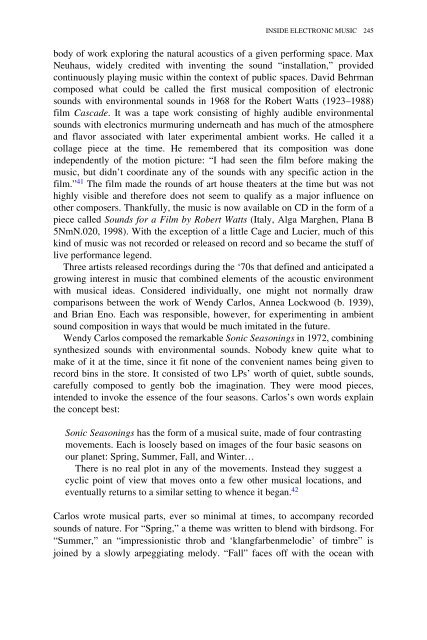Electronic and Experimental Music: Pioneers in ... - Aaaaarg
Electronic and Experimental Music: Pioneers in ... - Aaaaarg
Electronic and Experimental Music: Pioneers in ... - Aaaaarg
Create successful ePaper yourself
Turn your PDF publications into a flip-book with our unique Google optimized e-Paper software.
INSIDE ELECTRONIC MUSIC 245<br />
body of work explor<strong>in</strong>g the natural acoustics of a given perform<strong>in</strong>g space. Max<br />
Neuhaus, widely credited with <strong>in</strong>vent<strong>in</strong>g the sound “<strong>in</strong>stallation,” provided<br />
cont<strong>in</strong>uously play<strong>in</strong>g music with<strong>in</strong> the context of public spaces. David Behrman<br />
composed what could be called the first musical composition of electronic<br />
sounds with environmental sounds <strong>in</strong> 1968 for the Robert Watts (1923–1988)<br />
film Cascade. It was a tape work consist<strong>in</strong>g of highly audible environmental<br />
sounds with electronics murmur<strong>in</strong>g underneath <strong>and</strong> has much of the atmosphere<br />
<strong>and</strong> flavor associated with later experimental ambient works. He called it a<br />
collage piece at the time. He remembered that its composition was done<br />
<strong>in</strong>dependently of the motion picture: “I had seen the film before mak<strong>in</strong>g the<br />
music, but didn’t coord<strong>in</strong>ate any of the sounds with any specific action <strong>in</strong> the<br />
film.” 41 The film made the rounds of art house theaters at the time but was not<br />
highly visible <strong>and</strong> therefore does not seem to qualify as a major <strong>in</strong>fluence on<br />
other composers. Thankfully, the music is now available on CD <strong>in</strong> the form of a<br />
piece called Sounds for a Film by Robert Watts (Italy, Alga Marghen, Plana B<br />
5NmN.020, 1998). With the exception of a little Cage <strong>and</strong> Lucier, much of this<br />
k<strong>in</strong>d of music was not recorded or released on record <strong>and</strong> so became the stuff of<br />
live performance legend.<br />
Three artists released record<strong>in</strong>gs dur<strong>in</strong>g the ‘70s that def<strong>in</strong>ed <strong>and</strong> anticipated a<br />
grow<strong>in</strong>g <strong>in</strong>terest <strong>in</strong> music that comb<strong>in</strong>ed elements of the acoustic environment<br />
with musical ideas. Considered <strong>in</strong>dividually, one might not normally draw<br />
comparisons between the work of Wendy Carlos, Annea Lockwood (b. 1939),<br />
<strong>and</strong> Brian Eno. Each was responsible, however, for experiment<strong>in</strong>g <strong>in</strong> ambient<br />
sound composition <strong>in</strong> ways that would be much imitated <strong>in</strong> the future.<br />
Wendy Carlos composed the remarkable Sonic Season<strong>in</strong>gs <strong>in</strong> 1972, comb<strong>in</strong><strong>in</strong>g<br />
synthesized sounds with environmental sounds. Nobody knew quite what to<br />
make of it at the time, s<strong>in</strong>ce it fit none of the convenient names be<strong>in</strong>g given to<br />
record b<strong>in</strong>s <strong>in</strong> the store. It consisted of two LPs’ worth of quiet, subtle sounds,<br />
carefully composed to gently bob the imag<strong>in</strong>ation. They were mood pieces,<br />
<strong>in</strong>tended to <strong>in</strong>voke the essence of the four seasons. Carlos’s own words expla<strong>in</strong><br />
the concept best:<br />
Sonic Season<strong>in</strong>gs has the form of a musical suite, made of four contrast<strong>in</strong>g<br />
movements. Each is loosely based on images of the four basic seasons on<br />
our planet: Spr<strong>in</strong>g, Summer, Fall, <strong>and</strong> W<strong>in</strong>ter…<br />
There is no real plot <strong>in</strong> any of the movements. Instead they suggest a<br />
cyclic po<strong>in</strong>t of view that moves onto a few other musical locations, <strong>and</strong><br />
eventually returns to a similar sett<strong>in</strong>g to whence it began. 42<br />
Carlos wrote musical parts, ever so m<strong>in</strong>imal at times, to accompany recorded<br />
sounds of nature. For “Spr<strong>in</strong>g,” a theme was written to blend with birdsong. For<br />
“Summer,” an “impressionistic throb <strong>and</strong> ‘klangfarbenmelodie’ of timbre” is<br />
jo<strong>in</strong>ed by a slowly arpeggiat<strong>in</strong>g melody. “Fall” faces off with the ocean with












